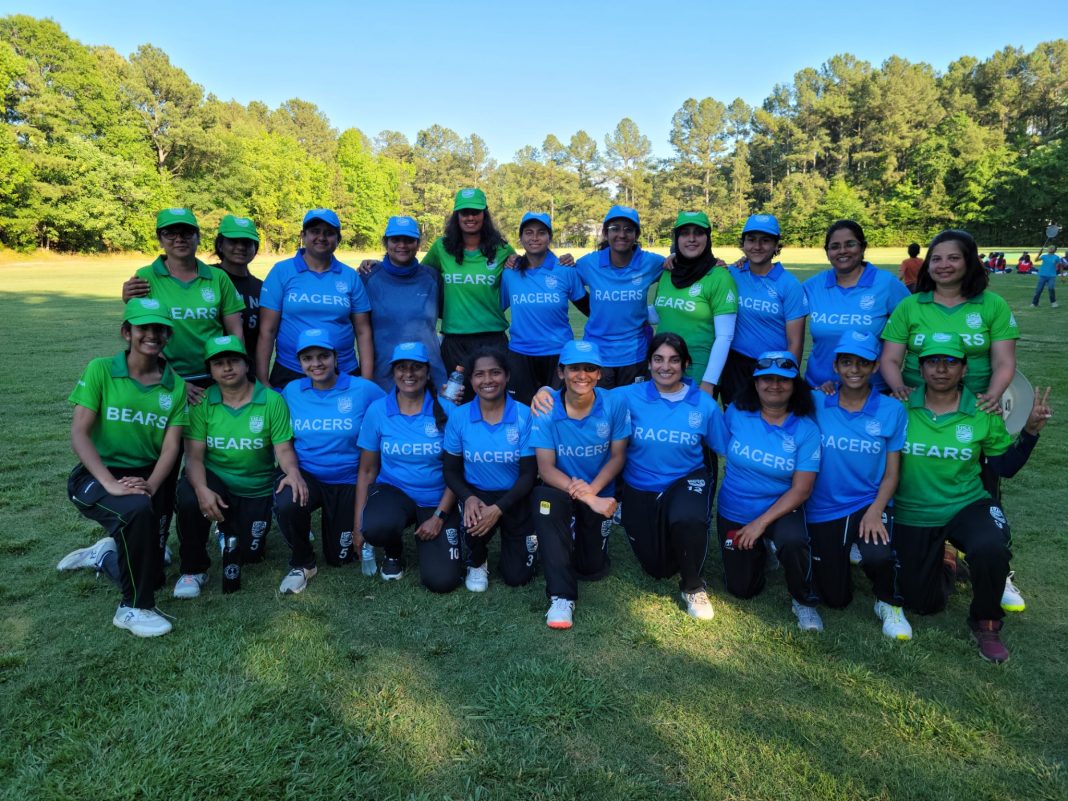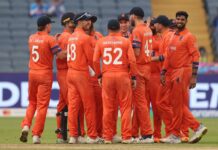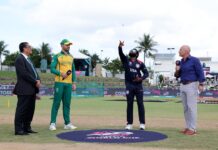Teams from 12 communities kicked off USA Cricket’s Women’s Intra-regionals last weekend. Morrisville, Philadelphia, Dallas and Sunnyvale combined to host 12 T20s and three 40 overs games in the first round of USA Cricket’s new domestic pathway system for women.
The games took place barely two weeks after the appointment of Volunteer Women’s Coordinators, and seven more games will proceed across the country next weekend (two T20s and five 40-over games) to wrap up the first round of the official women’s national selection pathway.
‘I was pleasantly surprised to hear that there are 12 women’s teams around the country. North Carolina, especially, were able to make two teams, which I find amazing,’ USA Women’s vice captain Shebani Bhaskar told Emerging Cricket following South East’s 2 run loss via DLS in a rain-shortened game to Chapel Hill Bears with Bhaskar not-out after 62 runs.
‘A lot of us, when we think of cricket in the US, we don’t think it’s very popular, and then if you take women’s cricket on top of that, you don’t really think there are going to be many players at all. I think a lot of us expected maybe six teams, but then to have twelve teams, it’s been amazing just the number of players, but also the passion and the energy that everyone is playing with. It doesn’t matter their skill level, but the passion and commitment to the game has been incredible this weekend.’
Shebani was born near Chicago, and moved with her family to India when her father was assigned as a US Diplomat. It’s there that she learned cricket, first playing as a kid with her cousin under the stairs on the side of their house. Flying in from India a couple weeks ago, Shebani was assigned to the South East team for the intra-regional round to help bring experience to a mostly green side.
‘A lot of our players from Atlanta are new to playing with a leather cricket ball. A lot of them transitioned very recently, I would say the past year, some as recently as three months ago, from hard tennis ball cricket. So of course the dimensions of the field, the type of ball, the way the ball will bounce, everything will be new to them. I was kind of impressed, it’s a hard ball, it hurts when you catch it, and no one flinched, they were ready to throw their bodies behind the ball and attempt every catch.’
Following this first round of games, teams will be reduced to four, with players reselected for the regional round to take place in July. The best players from the regional round will be divided into two teams to compete for the National Championship. The big idea is to allow selectors to pick the national team based on actual game performance, and give the women across the country a fair platform to get on the radar.
‘I feel great about this, I’m very excited by this pathway,’ Shebani continued.
‘Earlier – this is not just something that only happens in the US, but around the world – there would be selection trials where you’ll have nets, and you might have some open wickets, and that’s kind of how you end up selecting the teams. But to base it on match performance, whether it’s taking wickets or bowling economically, or scoring runs, or playing according to the situation…even if someone is not scoring as many runs as someone else, if they’re contributing to their team’s win, that’s valuable. These kinds of matches, the exposure you get when you play games, it’s unparalleled.’
Women’s Head Coach Julia Price and USA Women’s Coordinator Julie Abbott have been busy traveling the country, visiting cricket hubs and building connections with domestic leagues and players leading up to the intra-regionals. Emerging Cricket were lucky to discuss some of Coach Price’s observations on the condition of women’s cricket across the country at Shiloh Cricket Ground in Morrisville, North Carolina during one of the intra-regional games.
‘There’s a huge interest in the women’s game, but the infrastructure isn’t quite there for girls to be able to play regularly, to have access to facilities, all of that sort of stuff is probably the issue we’re facing at the moment,’ USA Cricket Women’s Head Coach, Julia Price told us.
‘Forming relationships with leagues and seeing how we can assist in grant writing, or getting more opportunities for girls to play more regularly is probably the key way of making sure that the girls’ game is going to continue to grow and improve at that top level as well.’
With women’s cricket at the ground floor in the United States, Price sees this competition as an important part of the bigger picture of building a quality national program. Price seems to view the current, unrefined state of the women’s game as an opportunity, rather than a grim reality check.
‘Well, the thing is, we can get it right pretty much early on. I think at the moment the domestic pathway that we’ve got put together, even though it’s not going to be that way forever, I think it’s a really good opportunity to allow girls in these intra-regionals to be able to play at a slightly higher level in good quality cricket, lots of games, and probably also change the culture of what women’s cricket is currently in the country.’
‘(The current culture is) about tournaments, and thrown together teams, as opposed to having a real affinity with one team and that social aspect of coming together all the time in a community atmosphere. To me, these intra-regionals have been really good because they’ve broken up that culture currently, but (also) compliment what is currently happening around the place.’
‘I think this enables us to continue to focus on the top end, and continue to take the better players from this and then challenge them at another level and keep breaking it down so that we get the top 24 players in the country playing in the national championships. That won’t always be the system, but for the moment and for the numbers we’ve got, I think it’s the best for making sure our girls are as prepared as possible for the top end.’
‘At the same time, it allows for us to build down as well into communities. The response we’ve got from putting out the social media posts, and the registrations about this competition has been great, and we’re able to now talk to leagues about the numbers of girls who went along to those trials that were interested, and maybe start some women-only competitions, so that they can play more regularly, week-in, week-out against other women and girls. To me, that’s a win for all cricket at all levels. We’ve got a big job obviously at this stage, because we’re trying to grow everything, but I think the pathway doesn’t have to be high performance, it’s a pathway from grassroots all the way up to the top.’
When the topic of developing the game in the broader US mainstream is brought up, there’s enthusiasm visible in the smiling face of Price, an obvious passion that’s backed up by years of relevant experience across the globe. This passion is tempered by an understanding of just how far there is to go, but challenges like this aren’t new to the well traveled coach.
Many of Julia Price’s accomplishments are well documented and well known by followers of women’s cricket in Australia: keeping wicket for two World Cup teams for Australia, and becoming the first woman to coach men in the Big Bash League come to mind right away. But her history brings a vast amount of varied experience which directly applies to the mission of USA Cricket’s women’s program.
Price didn’t pick up cricket competitively until she was 17. While growing up a fan of Australia’s biggest sport and playing recreationally with friends certainly helped prepare her for the challenge, it was watching women’s cricket on TV that made her think of cricket as a possibility for her. Prior to cricket, Price enjoyed other sports competitively, particularly softball. But with cricket, Price found exceptional success, and debuted with the Australian national team a year after her maiden First Class match.
After a long and successful cricket career, which included coaching stints overseas during southern hemisphere winters, Price turned to coaching full time, helping develop the women’s game in Tasmania, Australia’s smallest state. Price also crossed over into another sport, popularizing women’s Australian rules football in Brisbane while working with the Brisbane Lions of the AFLW.
Price sees potential for crossover athletes in the USA as well, ‘Particularly because we’re trying to get it into mainstream America. At the moment there are a lot of Caribbean and South East Asians and Expats playing the game, and if cricket is going to become a mainstream sport, we need Americans from all different cultures and diversity playing in the game. We’ve had a couple girls, we always bring up Erica Rendler, coming from softball, though she did recently mention (on Peter Della Penna’s Stars and Stripes Cricket Podcast) she hasn’t played softball since she was 16, and obviously Nadia Gruny came from soccer.’
‘But look at Australia, you’ve got somebody like Ash Barty, she played one year in the WBBL, and she’s the number one tennis player in the world, so there are definitely skills in the crossover, playing sports when you’re young, that can be transferred into cricket, and vice versa. I’m sure a lot of cricket skills can be transferred into other sports. I think we do tend to get a little carried away with just being cricket, cricket, cricket, every day, it’s about enjoying the game as well. If I had to train every single day when I was a child playing cricket, I probably wouldn’t have been playing in my twenties, I’d be sort of over it.’
‘I still think there’s a social element, you want to enjoy your life, you want to enjoy the games you’re playing. If cricket happens to be the sport you choose full time after that, well fantastic, but at the same time we want to get people from other sports trying our sport, and likewise I’d love our girls to pick up a few other sports and have a break from cricket every now and then.’
Should covid protocols not stand in the way, USA’s women’s team will host Canada, Argentina and Brazil for the ICC T20 Women’s World Cup Americas Qualifiers. Brazil’s women’s team made history in January of 2020 becoming the first Associate women’s team to contract women’s players ahead of men’s. Contracts may be in the distant future for American women’s players, but the hope is that women can play a big role leading cricket into the mainstream in the USA.
‘I think they can still concentrate on the men’s team, (and find) opportunity with investment in the women’s game. We’re currently ranked number 32, with about 400 players in the country. This program will just make those 400 stronger, if not grow it even further in the next 3 to 4 years. In that time period, I think we can at least get in top 20, or low 20s anyways, so long as we’re getting constant international games.’
‘But then playing week in and week out in a quality pathway program I think is a really easy win for USA Cricket, and I think the number of girls that may take up the game, because of the international opportunities and success that the girls are having, I’m sure it’s very much like the women’s soccer team, and absolutely the Australian women’s team back home, they’ve gone gangbusters with their numbers, based on the fact that they’re number one in the world in all formats. You know success brings people, and people want to be involved in successful programs, and obviously cricket is such a unique sport in the fact that it’s very individual oriented, but also in the fact that it’s a great social team sport as well.’
Proud and hopeful after the successful debut weekend of USA’s first pathway event for women, Shebani Bhaskar makes a similar comparison. ‘I think there’s a lot of potential. We’ve seen what has happened in women’s soccer in the country, in ten years they’re a world beating team, they’re dominating world soccer. Definitely us as Americans, we love our sport, and if cricket captures the imagination of the american fan, we’re going to take off.’
You’re reading Emerging Cricket — brought to you by a passionate group of volunteers with a vision for cricket to be a truly global sport, and a mission to inspire passion to grow the game.
Be sure to check out our homepage for all the latest news, please subscribe for regular updates, and follow EC on Twitter, Facebook, LinkedIn and YouTube.
Don’t know where to start? Check out our features list, country profiles, and subscribe to our podcast.
Support us from US$2 a month — and get exclusive benefits, by becoming an EC Patron.







